Passing game
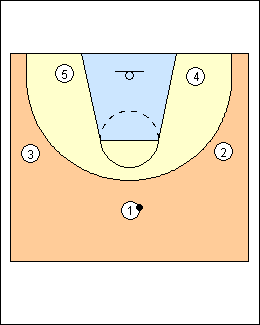 | 1 Hal Wissel FIBA Assist issue 18 The 3-2 open set or spread formation is the most basic formation to learn team offence. The point position is above the top of the 3-point line, the wings are foul-line extended, the baseline positions are halfway between the corner and the basket on each side. The passing game is guided by principles. See Offences - Huggins open post, Youth, Bigelow 5-out youth, also 4-out 1-in motion. Basic principles 1. Talk. 2. See the rim and the ball. 3. Maintain 15-20 foot spacing and court balance. 4. Cut backdoor to the basket if overplayed or your defender's head is turned away from you. 5. If a teammate is denied and doesn't backcut, and you are the next player away from the receiver, flash to an open area between the passer and the overplayed receiver. 6. Keep the middle open - when you cut to the basket, don't stay in the post area for more than a one-count, continue on through and fill an open spot on the side of the floor with the fewest players. 7. When you are the next player away from a cutter, quickly move to the vacated spot, especially to replace a player who has cut from the point position (cut high above the 3-point line). 8. If you catch the ball on the wing you should be a triple threat, if you are outside your range, hold the ball for a count of two, look to a) pass inside to a player cutting or posting, b) drive and kick (especially when the ball is reversed from one wing to the other), c) balance the court by dribbling to the point (pass to a baseline player only if he is open for a shot within range, or can make an easy pass inside, you can swing the ball more quickly if you keep it off the baseline). 9. With the ball at the point, your options are reverse the ball quickly, look inside, drive and kick, or fake ball reversal and pass back. 10. At the baseline position, look to set up your defender to use a downscreen or to backscreen for a wing player, and be alert to flash to the ball when a wing is denied. 11. If you get the ball in the low post, look to score before passing, if you don't get the ball, look to backscreen for a perimeter player, then pop out to the perimeter for a pass and shot. 12. On a shot, the point and another outside player should get back for defensive balance, the shooter gets back on a shot outside the lane, if the player at the point drives the basket, the players at the wings get back. Ken Atkins - passing-game offences are rules-oriented, they require continuous action, but it's not a set movement pattern, players read the defence and respond. |
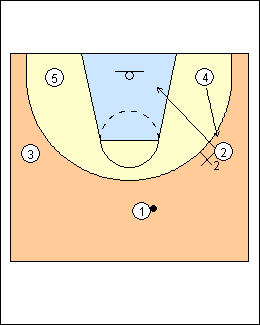 | 2 If denied with the ball at the point, closest wing 2 backcuts to create an open area for baseline player 4, using a designate signal. Once you start to go backdoor, go all the way to the basket, preventing a possible turnover. |
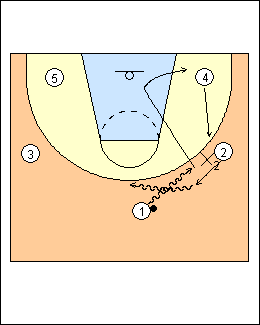 | 3 Or 1 could initiate movement by dribbling at 2, making a handoff, setting a screen, then cutting to the basket. If his defender is slow getting over the screen, 2 looks to turn the corner and drive to the basket. If his defender slides under the screen, 2 looks to shoot or take at least two dribbles and pass back to screener 1 rolling to the basket or popping out. If the defenders jump switch the handoff, the screener should make a short 5-10 foot cut to an open area and look for a return pass. If he anticipates the jump switch, he can fake the handoff and drive to the basket. If the defenders trap the handoff, the receiver should retreat dribble to stretch the defence then pass to the screener making a short cut to an open area. If X2 tries to prevent the handoff, 2 backcuts. A weave involves at least three players who dribble screen and handoff for each other. After getting a handoff, shoot from behind the screen, drive to the basket, or continue the weave by driving toward another teammate. |
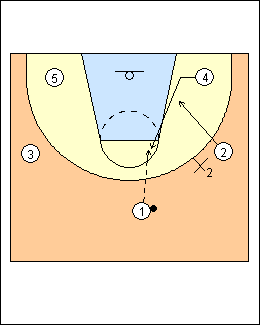 | 4 Here with the wing overplayed, next player 4 flashes high to the ball then looks to hit 2 on a backdoor cut. |
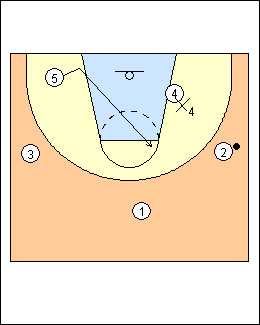 | 5 You can flash to the high post when a teammate is being fronted in the low post (shown), or flash to the low post if he is being denied at the high post. |
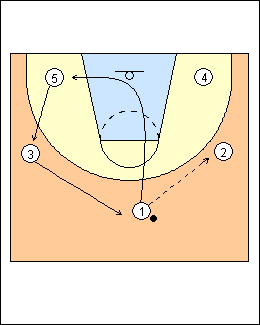 | 6 The give and go is the most basic play in basketball. Fake away and front cut, or fake toward the ball (to set a screen or get a handback) and backcut. |
 | 7 Downscreen Take a few steps toward the basket before setting the screen, to get a better angle on the defender. You want him to go under the screen. Communicate the screen to the cutter, e.g., "down". His four basic options are pop-out, curl, backdoor cut, and fade. He must be patient, waiting for the screen to be set and reading how the defence is playing it. He sets a good angle to cut off the screen by first moving in the direction his defender is playing, then cutting off the screen in the opposite direction, far enough away from the screen that one defender can't guard both players. If defenders switch, the screener will be ballside of the defender he screened, momentarily open. On a downscreen at the elbow (shown), the cutter should look to curl, the screener's defender will usually help or switch, freeing the screener to pop out for a pass. The elbow curl is best used when a smaller player sets a screen for a bigger player. Ken Atkins - the screener communicates a screen by raising his fist or calling the cutter's name, screens with his back to area where the cutter will get open, and steps towards the ball after the cutter uses the screen. If the defence switches too soon or cheats prematurely to bump the cutter, the screener slips to the basket or an open area. The cutter waits for the screen (it's better to go off a screen late than early), makes the defence think he is heading in one direction but then moves the opposite way (a v-cut is encouraged), reads the defence and comes off the screen to an open area, fades, or curls. |
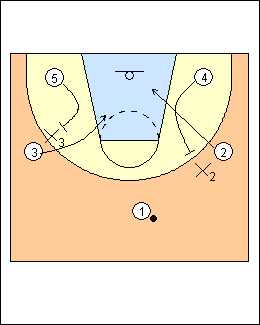 | 8 Backscreen To set a backscreen, take a few steps towards the basket to get a better angle, and communicate the screen with a designated keyword. Set a legal screen, no closer than a normal step if you are screening a stationary defender. The basic options for the cutter are front cut, backdoor cut, pop-out, and fade. On a front cut or backdoor cut to the basket, the screener will be free to pop out for a pass. Ken Atkins - a backscreen for a passer is best because his defender is likely close by. The cutter fades to an open area if his defender goes over the screen (gets caught in or near the lane), the screener could cut to the basket but will most likely pop out. If defenders switch, the cutter fades or pops back, the screener seals and breaks to the basket with the defence trailing. |
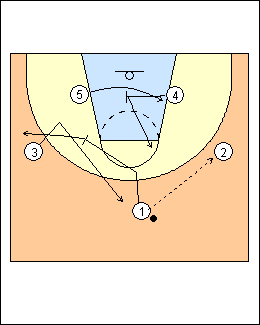 | 9 Cross-screen The screener starts at one block and screens across for a teammate at the other block, who reads the defence and cuts over or under the screen. If the cutter goes to the ballside block, the screener pops out to the ballside elbow area (shown), if the cutter flashes high to the elbow, the screener should roll back to the ballside block. Ken Atkins - if defenders switch, the cutter always goes high, the screener seals back low. |
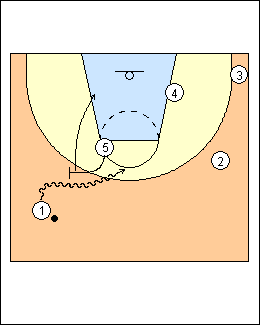 | 10 Pick and roll Defending on how it is defended, options are pick and roll, pick and pop, slip, and stretch a trap. If defenders switch, the screener will momentarily be inside the defender he screened, free to roll to the basket looking for a pass. Ken Atkins - the screener rolls early if the on-ball defender goes under the screen, holds the screen a little longer than usual if the on-ball defender cheats early over the screen and the dribbler goes away from the screen (rejects the screen baseline), and slips the screen if his defender steps out too soon to hedge. If defenders switch, the screener heads to the basket, the dribbler takes advantage of any mismatches, he may dribble back to the original location to get the ball inside to the post, other players vacate the region to let their two teammates exploit the mismatch. |
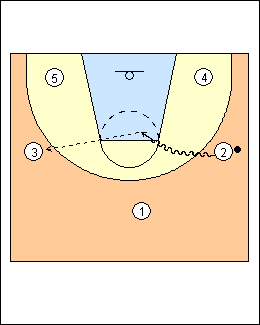 | 11 Draw and kick Penetrate and pass. Because the passing game depends primarily on moving the ball, over-dribbling becomes counter-productive. Draw and kick is best used from the wing after the ball has been swung from the other side, options include driving to the basket, a pull-up, passing inside, and passing outside. |
This page was made with Basketball playbook from Jes-Soft